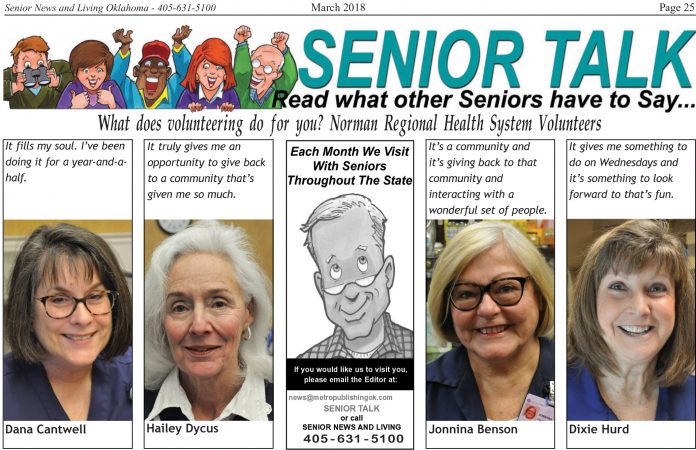* Focus, Rehabilitation and Tribal Facilities numbers are not assigned to a specific region as their patient populations reside across the state. Information provided through survey of Oklahoma hospitals as reported to HHS as of the time of this report. Response rate affects data. Facilities may update previously reported information as necessary. Data Source: Acute Disease Service, Oklahoma State Department of Health. *As of 2021-06-24 at 7:00 a.m
SENIOR TALK: What does volunteering do for you?
What does volunteering do for you? Norman Regional Health System Volunteers
It fills my soul. I’ve been doing it for a year-and-a-half. Dana Cantwell
It truly gives me an opportunity to give back to a community that’s given me so much. Hailey Dycus
It’s a community and it’s giving back to that community and interacting with a wonderful set of people. Jonnina Benson
It gives me something to do on Wednesdays and it’s something to look forward to that’s fun. Dixie Hurd
The wizard of Ozzie
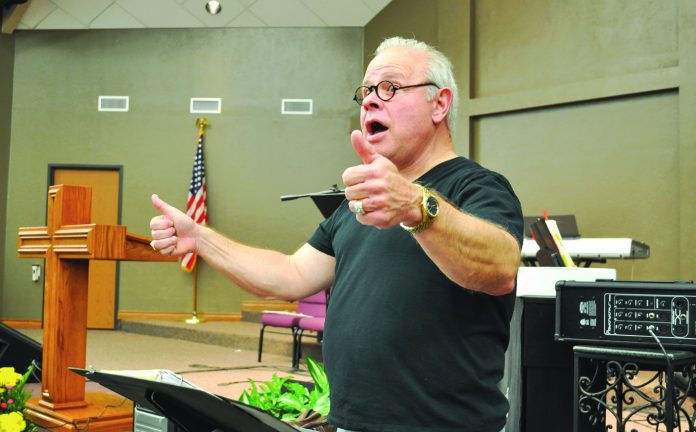
story and photos by Bobby Anderson, Staff Writer
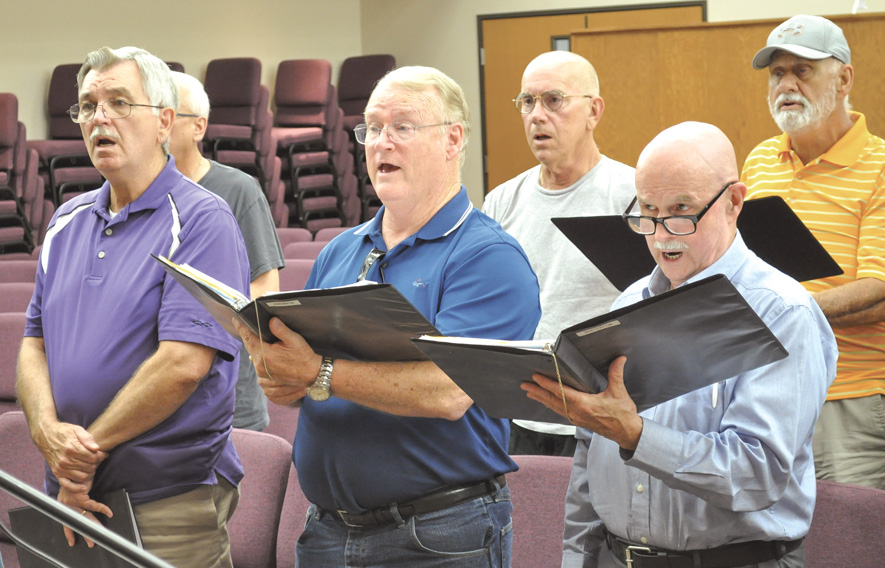
On Sundays strangers gather at New Heights Baptist Church on the city’s south side and sing their praises to the Lord.
But each Monday night, Capitol Hill alumni get together at New Heights to sing in praise of Albert “Ozzie” Ossenkop.
Randy Parsons directs Ozzie’s Capitol Hill Alumni Choir, a group composed solely of individuals taught by the local choral legend.
Members are either Ossenkop’s former students, their spouses or those he taught in church choirs.
Membership is by audition only and encompasses Capitol Hill students from 1963 to 1972.
“But we all auditioned 50 or 60 years ago,” Parsons laughed. “Ozzie was a great showman, a great choral director and taught us not only the love of music but he loved all of us.
“He made us feel special.”
The choir started after a couple of large reunions honoring their former director. Hundreds of students came out of the woodwork for those.
Ossenkop taught for 34 years and passed in 2011 at the age of 89.
During the later years, the group gathered each Christmas to serenade him at Legend at Rivendell.
“Many of the choir stayed in touch and would come to visit and still consider him like a father,” Parsons said. “As he aged our love for him probably increased because we could care for him a little bit like he cared for us.”
But when Ossenkop passed there was a void.
A couple of alumni got the idea of gathering members to sing for the lighting of the Stockyards Christmas tree.
“That’s what got us started and now we are the official choir of Stockyards City and we sing every year at the lighting,” he said. “We figured if we were going to do this let’s do this with the songs Ozzie taught us.”
The choir doesn’t just sing, it performs Ossenkop’s original arrangements he taught back in high school.
This will be the fourth season for Ozzie’s Capitol Hill Alumni Choir, which performs around 14 shows yearly.
In late August, the group performed at the Capitol Hill Alumni Association Annual Banquet.
One of Ossenkop’s students made it all the way. Tenor Chris Merritt has performed all over the world from Carnegie Hall to London’s Royal Opera House.
Ossenkop took his choirs all over as well. Disneyland, Montreal, San Antonio – Ossenkop’s choirs toured performing his annual Musical Extravaganza, a collection of show tunes he arranged.
Member Cheryl Tolsen was part of Ossenkop’s last choir. Coincidentally, her mother was in Ossenkop’s first choir.
“The alto doesn’t fall far from the tree,” Parsons joked.
On Monday nights you’ll find Kathy Perkins, Class of 1968, accompanying the choir on piano the same way she did in high school.
Following Labor Day, Parsons said the group will look to add more members. Anyone who was taught by Ossenkop is welcome to join this month to begin work on the group’s Christmas performances.
Carol Netherton (Class of 68) serves as the group’s secretary and treasurer.
“He was just full of vitality and vivaciousness,” she remembered. “I don’t know anybody who didn’t like him. He was like a father to so many.”
Alana Stephens (Class of 69) described her mentor as ‘“a big old teddy bear.” Seeing Ossenkop each morning at 7:25 a.m. was always a treat.
“He really was interested in all of us kids,” Stephens said. “He wasn’t just a teacher.”
Ossenkop’s expectations were straightforward: no smoking, no drinking, be an A+ person.
Even decades later, when Ossenkop would see one of his students he could tell them what voice part they sang and even remembered details about their families. “One teacher’s influence has been multiplied over all these years and is still being multiplied,” Parsons said. “Nobody pays these people to come. They have to put up with me but they come week after week, year after year. We enjoy each other but our main motivation is we want to honor the guy that started it all.”
Ossenkop left an indelible mark on every member of the choir.
Juanita Gasaway (Class of 1968) still has two pictures of Ossenkop on her cell phone. The first is of him holding her first son in 1970. The second was Ossenkop holding her son’s son in 2010.
“He had a heart of gold,” Gasaway said.

Discovering Unique Finds in a Vintage Antique Mall
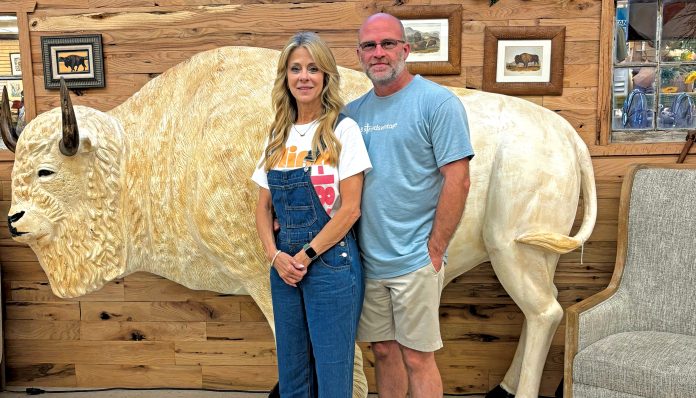
Story and Photo by Vickie Jenkins, Staff Writer
Do you want to catch a glimpse of your past and relive precious memories? Stepping into 3 Strands Vintage Antique Mall feels like traveling back in time, where every corner is filled with the charm of yesteryear. Nostalgic treasures from decades gone by surround you, offering a delightful mix of retro signs to vintage furniture and classic fashion pieces. As you wander through the aisles, you’ll find items that bring back memories to the simple times. The displays invite you to explore, making each visit and experience where the past and the present blend together, leaving you with a feeling of timeless connection to history.
Meet Dusty and Cindy Gardner, the passionate owners of 3 Strands Vintage Antique Mall, located at 4848 N.W. Expressway, Oklahoma City, OK. As the largest vintage and antique mall in Oklahoma City, OK it offers an inviting space for treasure hunters and collectors alike. With over 35,000 square feet of thoughtfully laid out displays, the mall is a haven for those seeking timeless pieces, from mid-century furniture to nostalgic decor. You are sure to find something unique and interesting to remind you of the past. There is spacious room to explore and discover hidden gems.
When asked what inspired Dusty and Cindy to open a vintage mall, Cindy smiled and explained, “ Dusty has always been fascinated by old, forgotten items, always searching for rare antiques,” she said. “What began as a small hobby quickly grew into a full-blown passion and before we knew it, we were needing more space, outside of our home,” she added. “We found the perfect place. We love the excitement of our customers when they discover their long-forgotten treasures. We’ve also fallen in love with the community and all of the incredible people who have come into our lives. Today, the mall has 127 vendors and on our big sale days, we welcome over 2,000 people through our doors.”
Cindy explained their vision behind creating 3 Strands Vintage Antique Mall, sharing how they wanted to build a space where both vendors and customers could feel appreciated and valued. “We envisioned a community where passions could grow, where vendors could thrive and customers could find unique treasures that gave them that personal feeling.” She went on to say that their journey was guided by faith. “We began to pray for direction and clarity, trusting that through faithful prayer, the right path would unfold. Little by little, our dream became a reality and now, we have a place where everyone can gather, prosper and connect in meaningful ways, and keeping our focus on God in everything we do. This commitment to faith and community has become the heart and soul of 3 Strands Vintage Antique Mall, where business thrives and relationships flourish,” she said with a smile.
When asked if she believed there would always be a demand for antiques, even with the growing popularity of modern design, Cindy responded thoughtfully, “I truly believe there will always be a desire for antiques,” she said with confidence. “After all, antiques carry stories and memories that can’t be replaced by modern pieces. Modern designs has its place, but antiques offer something unique, a sense of nostalgia and the chance to hold a piece of time in your hands. I think that the emotional connection is something people will always seek.”
When asked about their personal favorite item in the store, Cindy smiled and thought for a moment before answering. “Well, I’m pretty sure Dusty’s favorite is the vintage gas pump we have. He’s always been fascinated by unique, industrial pieces like that.” she shared. “As for me I’d have to say my favorite is the authentic stagecoach we have on display. It’s such a striking piece of history. Every time I look at it, I think of the stories it could tell and the journeys it’s been on. Now, we both have a soft spot for the big buffalo that stands proudly in our store. It’s one of those pieces that really catches peoples attention when they walk in.”
Overall 3 Strands Vintage Antique Mall strives to be remembered as something far more than just another antique mall. They aim to be a place where history, community and passion come together, offering an experience that leaves a lasting impression on everyone who walks through their doors.
3 Strands Vintage Antique Mall, is more than just a place to find unique treasures; it’s a bridge that connects generations, sparking curiosity and nostalgia in young and old alike.
SAVVY SENIOR: What’s the Difference Between Alzheimer’s and Dementia?
Dear Savvy Senior, What’s the difference between Alzheimer’s disease and dementia? My aunt has dementia, but they don’t know if she has Alzheimer’s disease, which is very confusing to me. Trying To Understand
Dear Trying,
Many people use the words “Alzheimer’s disease” and “dementia” interchangeably, but they are not the same thing. In fact, you can have a form of dementia that is completely unrelated to Alzheimer’s disease. Here’s what you should know.
Dementia versus Alzheimer’s
Dementia is a general term for a set of symptoms that includes memory loss, impaired communication skills, a decline in reasoning and changes in behavior. It most commonly strikes elderly people and used to be referred to as senility.
Alzheimer’s disease is a specific illness that is the most common cause of dementia. Though many diseases can cause dementia, Alzheimer’s – which affects 5.7 million Americans today – accounts for 60 percent to 80 percent of dementia cases, which is why you often hear the terms used interchangeably.
But there are many other conditions that can cause symptoms of dementia like vascular dementia, which is the second most common cause, accounting for about 10 percent of dementia cases. Vascular dementia is caused by a stroke or poor blood flow to the brain.
Other degenerative disorders that can cause dementia include Lewy body dementia, Parkinson’s disease, Frontotemporal dementia, Creutzfeldt-Jakob disease, Chronic Traumatic Encephalopathy (CTE), Huntington’s disease and Korsakoff Syndrome. Some patients may also have more than one form of dementia known as mixed dementia.
Dementia is caused by damage to brain cells, but the symptoms can vary depending on the cause. In the case of Alzheimer’s disease, protein fragments or plaques that accumulate in the space between nerve cells and twisted tangles of another protein that build up inside cells cause the damage.
In Alzheimer’s disease, dementia gets progressively worse to the point where patients cannot carry out daily activities and cannot speak, respond to their environment, swallow or walk. Although some treatments may temporarily ease symptoms, the downward progression of disease continues and it is not curable.
But some forms of dementia are reversible, which is why it’s important to be evaluated by a physician early on. Vitamin deficiencies, thyroid problems, brain tumors, depression, excessive alcohol use, medication side effects and certain infectious diseases can cause reversible forms of dementia.
Another treatable form of dementia is a condition known as normal pressure hydrocephalus, which is caused by a buildup of cerebrospinal fluid in the brain that can be relieved by surgically implanting a shunt to drain off excess fluid. This type of dementia is often preceded or accompanied by difficulty walking and incontinence.
To learn more about the different types of dementia, including the symptoms, risks, causes and treatments visit the Alzheimer’s Association at ALZ.org/dementia.
Send your senior questions to: Savvy Senior, P.O. Box 5443, Norman, OK 73070, or visit SavvySenior.org. Jim Miller is a contributor to the NBC Today show and author of “The Savvy Senior” book.
Health Officials Warn Residents of Heat-Related Illnesses
Summer is heating up, and as temperatures rise, so does the risk of heat-related illness. Each year, approximately 620 people die from heat-related illness in the United States.
The Oklahoma State Department of Health (OSDH) reminds residents that heat-related illness can range from heat rash, heat cramps and heat exhaustion to hyperthermia (overheating) and heat stroke. Heat stroke occurs when the body is unable to cool itself sufficiently, and it often results in severe organ damage or even death.
It is important to recognize the signs of heat exhaustion and heat stroke and act quickly.
Heat Exhaustion
* Heavy sweating
* Weakness
* Cold, pale, clammy skin
* Fast, weak pulse
* Nausea or vomiting
* Fainting
* Muscle cramps
* Headache
* Feeling dizzy
Heat Stroke
* Body temperature of 103 degrees or higher
* Hot, red, dry or moist skin
* Rapid and strong pulse
* Headache
* Nausea
* Feeling confused
* Feeling dizzy
* Unconsciousness
A heat stroke is a medical emergency. If any signs are recognizable, call 911 immediately and move the person to a cooler environment. Reduce the person’s body temperature with cool cloths or even a bath.
The OSDH offers the following safety tips for preventing a heat-related illness: Stay indoors. Stay in an air-conditioned place. If your home is not air-conditioned, visit the mall or public library, or contact the local health department for the location of a heat-relief shelter in the area.
Stay hydrated. Increase your fluid intake to two to four glasses (16-32 ounces) of cool fluids every hour. If you are on water pills or restricted fluid limit, consult a physician first. Avoid liquids which contain alcohol or large amounts of sugar; they contribute to the loss of more body fluid. Very cold drinks can cause stomach cramps and should be avoided as well.
Dress appropriately. Wear lightweight, light-colored, loose-fitting clothing as well as sunscreen with SPF 15 or higher and broad spectrum or UVA/UVB protection.
Closely monitor those who are more vulnerable. Infants, children, people older than 65 years of age, those with mental illness, outdoor workers, athletes and those with physical illnesses such as heart disease or high blood pressure should be closely observed.
Never leave anyone in a vehicle. Never leave anyone, especially children and the elderly, in a parked vehicle, even if the windows are cracked.
Superbugs: Why antibiotic resistance is a fast-growing crisis
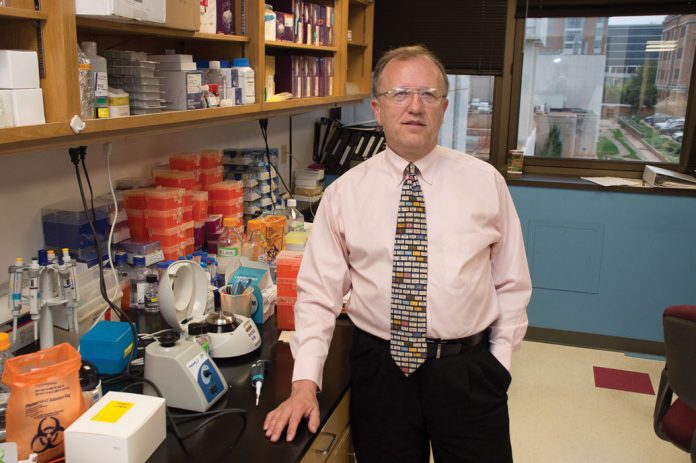
The world is running out of antibiotics.
In a new report from the World Health Organization, research showed that too few new antibiotics are being developed to counter the growing threat of infections that are resistant to currently available antibiotics.
“Antibiotic resistance is one of the biggest and fastest-growing health crises facing our planet,” said Oklahoma Medical Research Foundation immunologist Hal Scofield, M.D. The CDC estimates that 23,000 Americans die each year from infections that don’t respond to standard treatment with antibiotics. And this number is only going up.
Antibiotic resistance occurs when a bacteria, fungi, or parasite is no longer curable by medicines previously able to treat them. For example, if you give a patient antibiotics and it kills 99.9 percent of the bugs that are causing the disease, the 0.01 percent that survive can become superbugs that are resistant to the medication.
“This happens routinely, and we know it’s going to continue until protocols are established in medicine to minimize it,” said OMRF President Stephen Prescott, M.D., a physician and medical researcher. “Unfortunately there are a lot of forces working in the other direction.”
The primary cause for the surge in superbugs is excessive use of antibiotics. According to the CDC, healthcare providers write 47 million unneeded antibiotic prescriptions each year in the U.S. alone. “It’s routine for antibiotics to be prescribed for conditions that they can’t treat, things like sore throats, colds and other viral infections,” said Prescott.
Scofield emphasized that patients also bear some responsibility. “People often demand antibiotics from their healthcare providers in situations where they won’t help,” he said. “And for a variety of reasons—including the desire to please patients and to receive high customer-satisfaction ratings—the providers often reluctantly accept.”
Finding ways to administer antibiotics only when needed is important, said Prescott. But so is proper usage by patients once the drugs are prescribed. “This means never skipping doses or stopping treatment early, even if you feel better,” Prescott said.
He added that the use of antibiotics in animals like chickens, cattle and pigs may also be a culprit. “The drugs speed the animals’ growth and how much meat they have on them, but they are also very likely contributing in a significant way to the rapid rise of superbugs,” he said.
The new WHO report states that 51 antibiotics and 11 natural medical products are in development, but the fear is that it won’t be nearly enough, because many won’t make it all the way through trials to enter the market. The WHO also warns that many are only short-term solutions, as well, because most are just modifications of existing treatments.
“People in Oklahoma need to realize this isn’t a rare thing that only happens in third-world countries. It’s occurring all over,” Prescott said. “It’s a real problem and it’s not one that will be easily solved. There are big, wholesale structural changes that need to happen.”
OCU Hosts Exercise Pioneer Dr.
Oklahoma City University will host preventive medicine pioneer Dr. Kenneth H. Cooper for a presentation, open to the public, at 3 p.m. March 26 in the Kerr McGee Auditorium in Meinders School of Business. Following his presentation, the university will bestow Cooper with an honorary Doctor of Science degree.
Cooper, the founder and chairman of Cooper Aerobics in Dallas and an Oklahoma native, is credited with starting the international fitness movement following the release of his best-selling book, “Aerobics,” in 1968. This year marks the 45th anniversary of Cooper Aerobics inspiring millions of people to live healthier, longer lives.
He has lectured in more than 50 countries and is most famous in Brazil, having trained the 1970 Brazilian soccer team to a World Cup victory. As a result, jogging is translated as “coopering” in Portuguese.
Cooper’s efforts have also impacted the American diet. His collaboration with PepsiCo to eliminate trans fats from its Frito-Lay snack line encouraged other companies to follow suit.
Cooper was born in Oklahoma City in 1931. During his 13 years of service in the U.S. Army and Air Force, he served as a flight surgeon and director of the Aerospace Medical Laboratory. He developed the 12-minute and 1.5-mile fitness tests and the Aerobics Point System still used today by branches of the military, schools and organizations worldwide.
In 1970 Cooper resigned from the military and founded Cooper Aerobics Center in Dallas with the mission to explore the relationship between cardiovascular fitness and health and longevity. With the popularity of his book “Aerobics,” which has been translated into 41 languages and Braille, he also coined the term “aerobics” and submitted the official definition to the Oxford English Dictionary. He has authored 18 additional books, which combined have sold more than 30 million copies.
Cooper’s mission is for people of all ages to Get Cooperized™. As a leading pioneer of preventive medicine, he is challenging the world to follow his “8 Healthy Steps” to live better: maintain a healthy weight; eat healthy most of the time; exercise most days of the week; take the right supplements for you; stop smoking; control alcohol; manage stress; and get a regular, comprehensive physical exam. Founder and Chairman of Cooper Aerobics, Dr. Kenneth Cooper continues to lead the organization alongside his son, Dr. Tyler Cooper, president and CEO.
OKC Hospital Receives an ‘A’ for Patient Safety
SSM Health St. Anthony Hospital – Oklahoma City was awarded an ‘A’ from The Leapfrog Group’s Fall 2018 Hospital Safety Grade. The designation recognizes SSM Health St. Anthony Hospital, including SSM Health Bone & Joint Hospital at St. Anthony, for their efforts in protecting patients from harm and meeting the highest safety standards in the United States.
The Leapfrog Group is a national organization committed to improving health care quality and safety for consumers and purchasers. The Safety Grade assigns an A, B, C, D or F grade to hospitals across the country based on their performance in preventing medical errors, infections and other harms among patients in their care.
“At SSM Health St. Anthony Hospital and SSM Health Bone & Joint Hospital at St. Anthony, we take great pride in providing exceptional patient care. Safety is our number one priority for each patient that walks through our doors. Our employees go above and beyond every day, committed to the best safety practices, ensuring our patients receive the best care possible,” said Tammy Powell, President, SSM Health St. Anthony Hospital.
“Leapfrog’s Hospital Safety Grades recognize hospitals like SSM Health St. Anthony Hospital that focus on advancing patient safety. This ranking provides an important resource for patients, and a benchmark for hospitals, to determine how care at one hospital compares to others in a region,” said Leah Binder, president and CEO of The Leapfrog Group. “Hospitals that earn an A Hospital Safety Grade deserve to be recognized for their efforts in preventing medical harm and errors.”
Developed under the guidance of a National Expert Panel, the Leapfrog Hospital Safety Grade uses 28 measures of publicly available hospital safety data to assign grades to more than 2,600 U.S. hospitals twice per year. The Hospital Safety Grade’s methodology is peer-reviewed and fully transparent, and the results are free to the public.
SSM Health St. Anthony Hospital was one of 855 across the United States awarded an A in the Fall 2018 update of grades. To see full grade details of SSM Health St. Anthony Hospital, and to access patient tips for staying safe in the hospital, visit www.hospitalsafetygrade.org and follow The Leapfrog Group on Twitter and Facebook.

Founded in 2000 by large employers and other purchasers, The Leapfrog Group is a national nonprofit organization driving a movement for giant leaps forward in the quality and safety of American health care. The flagship Leapfrog Hospital Survey collects and transparently reports hospital performance, empowering purchasers to find the highest-value care and giving consumers the lifesaving information they need to make informed decisions. The Leapfrog Hospital Safety Grade, Leapfrog’s other main initiative, assigns letter grades to hospitals based on their record of patient safety, helping consumers protect themselves and their families from errors, injuries, accidents, and infections.
General Contractor & Subcontractor Charged with Forging Claims
Arrest warrants have been issued for a general contractor and a subcontractor charged with fraudulently padding an insurance claim. An investigation by the Oklahoma Insurance Department’s Anti-Fraud Unit found that Lisa Loven, 50, and Jeffrey Scott, 41, filed fake invoices with the insurance company for equipment that wasn’t used.
“Anyone who thinks insurance fraud is a victimless crime is dead wrong,” said Oklahoma Insurance Commissioner John D. Doak. “Insurance fraud leads to higher premiums for everyone. I will do everything in my power to prevent these crimes from happening and to make sure the perpetrators are punished.”
The Anti-Fraud Unit began investigating Loven in May after receiving complaints she was acting as an unlicensed public adjuster. One complaint involved an Edmond church that had received roof damage during a hailstorm on May 29, 2012. Investigators found Loven had submitted a typed invoice for $14,923 to pay for a rented crane to remove the church steeple.
When investigators contacted the owner of the crane rental company, he said he had never worked on the church and that his invoices are handwritten. The owner said he provided a handwritten estimate to subcontractor Jeff Scott of Edmond Roofing. After speaking with an independent adjuster hired by the insurance company, investigators learned that a crane was not used on the church repairs and the steeple was not removed.
Investigators believe Loven and Scott worked together to submit false documents to the insurance company for personal benefit. The Oklahoma County District Attorney has charged them with one count each of conspiracy to commit a felony and false claim for insurance.




